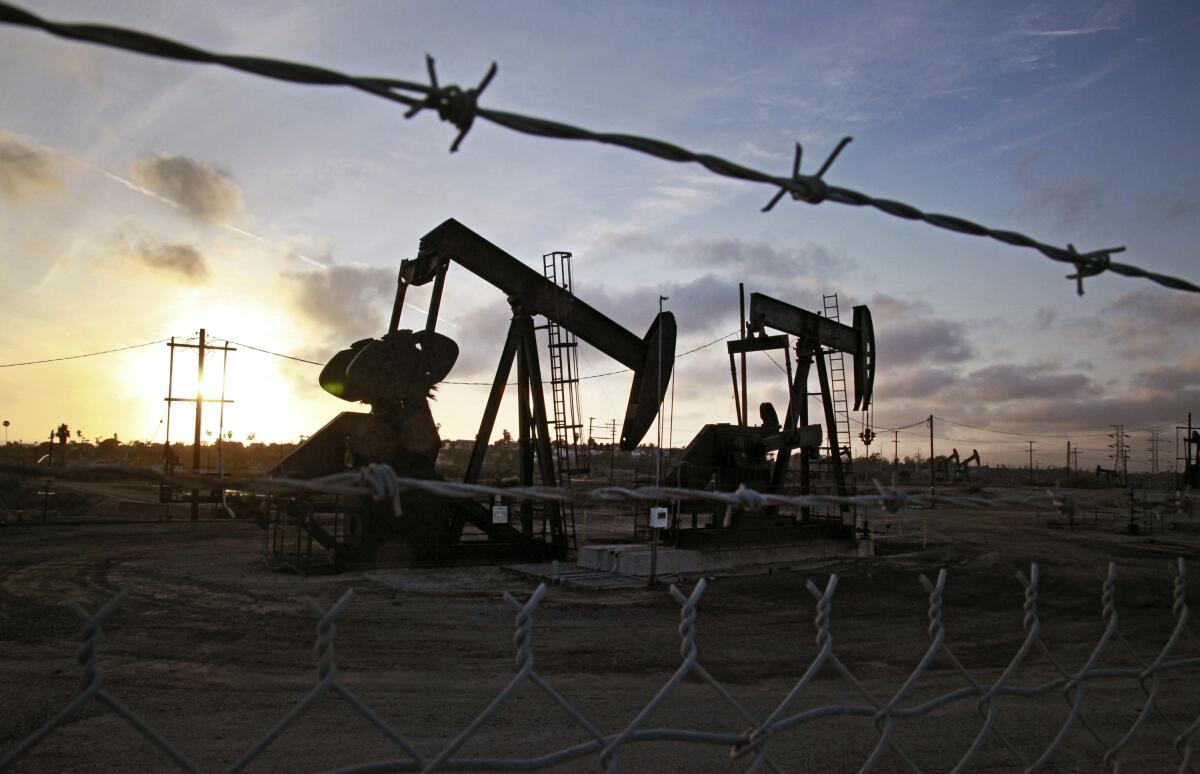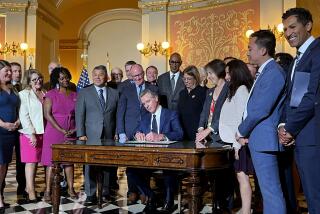Newsom’s pledge to ban fracking was all talk, no action

- Share via
A bill that would have outlawed fracking and dramatically curtailed oil and gas drilling in California died Tuesday, during its very first committee hearing. This wasn’t a surprise. Previous bills to limit oil and gas production, particularly near homes and schools, have failed in the Legislature amid fierce opposition from the fossil fuel industry and trade unions.
But this year was supposed to be different. Last fall, amid a record-breaking year for wildfires, Gov. Gavin Newsom declared: “This a climate damn emergency.” He committed to accelerate efforts to cut greenhouse gas emissions and counter the effects of a warming planet.
To great fanfare, Newsom came out with a far-reaching executive order to reduce the state’s reliance on fossil fuels. That included his commitment to work with the Legislature this year to ban new permits for hydraulic fracturing, or fracking, by 2024 to protect communities living near oil and gas drilling sites as well as trimming the state’s production of fossil fuels.
Fracking involves shooting a pressurized mix of water, sand and chemicals deep underground to extract oil and natural gas. The practice is used in only about 2% of the state’s oil production, but it’s highly controversial because of the potential to increase air pollution, contaminate drinking water supplies and trigger sinkholes near the well sites.
Newsom’s fracking pledge raised hope that this was the beginning of a larger move to reduce fossil fuel extraction, but also skepticism that the governor would actually follow through. Advocates have pushed Newsom to be far more aggressive in curtailing oil production; if the governor was so intent on phasing out fracking, why not pursue the ban himself through executive action? Instead, he punted the matter to the Legislature, where Democrats are notoriously split on oil and gas policy.
Some environmentalists predicted Newsom’s pledge would prove to be an empty promise. They were right.
The main Senate proposal to phase out fracking was Senate Bill 467 by Democratic state Sens. Scott Wiener of San Francisco and Monique Limón of Santa Barbara, a bill that would have banned new fracking permits starting next year. It came to an unceremonious end Tuesday at the Senate Natural Resources Committee, where it failed to get the five votes needed to stay alive.
Part of the challenge was that SB 467 went further and faster to rein in drilling than Newsom probably intended. Nevertheless, it appears Newsom did nothing to help the bill survive or evolve into something more politically feasible.
The bill would have banned new permits not just for fracking, but for any “enhanced oil recovery” methods that inject water, steam and additional substances into the ground to get oil out, starting Jan. 1, 2022. It would have banned such extraction methods entirely by 2027. That would have affected 80% to 95% of oil production in California, effectively shutting down most of the industry. The bill was recently amended to delay the full phase-out of injection methods until 2035, but that wasn’t enough to get more lawmakers on board.
The bill also would have prohibited oil or gas wells from operating within 2,500 feet of a home, school or healthcare facility, starting next year. A similar effort was blocked in the Legislature last year. Even so, a growing number of cities and states have enacted buffer zones to reduce health and safety risks from oil drilling. The Newsom administration is studying whether to mandate a minimum buffer zone statewide, but that proposed regulation has been delayed and delayed.
Perhaps the authors of SB 467 were too ambitious, despite the clear need to reduce the production and consumption of fossil fuels to better protect communities living near oil and gas industry operations and to help slow climate change. The state is the nation’s seventh-largest producer of oil, with more than 180 oil and gas fields. It’s unrealistic to think California could essentially shut down production in a few years without significant impact to communities that rely on the oil and gas industry for tax revenue and good-paying union jobs.
California needs a comprehensive plan to phase out petroleum production, not just fracking. That means bringing leaders from labor, industry and the environmental community together to chart a path forward so that the people and communities that have lived with or relied on oil and gas production aren’t left behind. Discussions have already begun through the governor’s Just Transition road map, but there’s much work and negotiation ahead. California doesn’t have time for empty promises.
More to Read
A cure for the common opinion
Get thought-provoking perspectives with our weekly newsletter.
You may occasionally receive promotional content from the Los Angeles Times.









